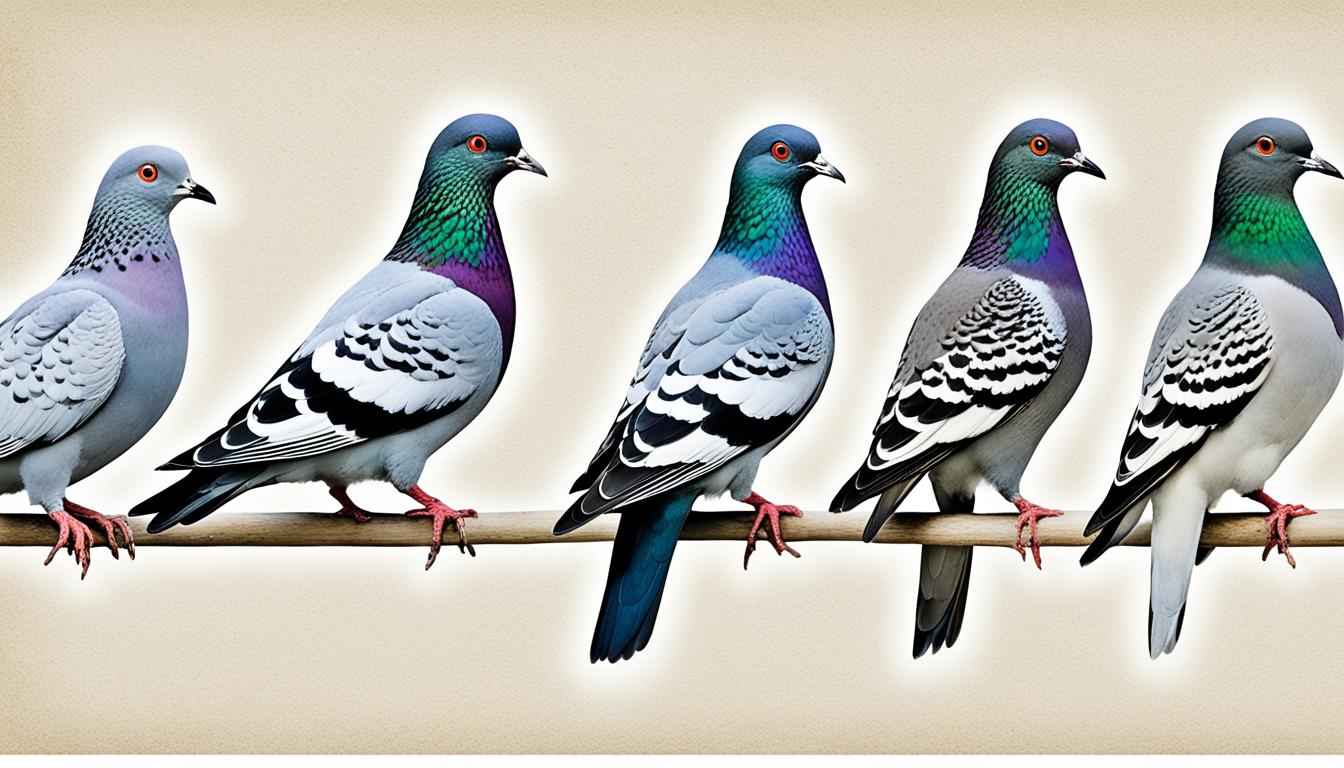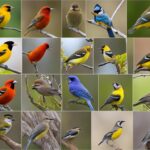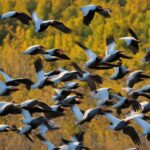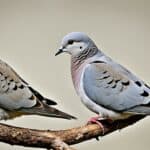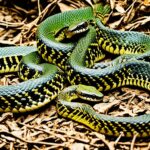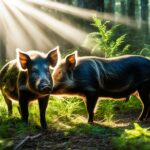Have you ever wanted to know how to recognize the various types of pigeons in North America?
The pigeons you spot in urban and rural areas might be from the Columbidae family. This group includes both pigeons and doves. It’s interesting to note that “pigeon” comes from French, while “dove” has roots in the Nordic languages.
Although size is a common way to tell them apart, the terms are often swapped. Pigeons in the USA are very smart. They can recognize themselves in mirrors. They can even tell the difference between letters and human faces. Recognizing pigeon species helps us understand them better and protect them.
Groups like the American Bird Conservancy are working to keep these birds safe. They face dangers such as losing their homes and getting poisoned by lead. You can help by looking after places where pigeons live and reducing the risk of birds hitting windows.
Introduction to Pigeon Species Identification
Learning about pigeons in the USA is key for bird enthusiasts. Many people mix up pigeons and doves. What’s the difference, you might ask?
Understanding Pigeons vs. Doves
The difference between pigeons and doves is more about how we use their names than their biology. They’re part of the same family. But we usually call the smaller ones “doves” and the bigger ones “pigeons”. This helps us talk about them clearly.
Importance of Identifying Pigeon Species
It’s important to identify pigeon species correctly. This knowledge is vital for saving them. In the USA, we have about 12 pigeons and doves to look out for. Spotting them isn’t just a fun pastime; it’s key for protecting them from dangers like lead and loss of homes. Knowing each species well helps us understand and protect them better.
Here’s a comparison to differentiate some of the pigeon and dove species:
| Feature | Pigeons | Doves |
|---|---|---|
| Size | Larger | Smaller |
| Common Terms | Rock Pigeon, Band-tailed Pigeon | Mourning Dove, Inca Dove |
| Habitats | Urban areas, cliffs | Open forests, desert scrub |
| Conservation Status | Varies (e.g., Rock Pigeon: stable) | Varies (e.g., Mourning Dove: stable) |
Common Characteristics of Pigeons in the USA
Pigeons in the USA show different traits that help us know them. These traits like their color, patterns, size, and shape are key. They help us tell the pigeon species apart.
Plumage Color and Patterns
Most pigeons are gray but with unique patterns. They have black wing bars and shining feathers on the neck. Paying attention to these details helps identify US pigeon species.
Size and Shape Differences
Pigeons are bigger and rounder than doves, with small heads and short legs. Knowing these features makes telling pigeon species in the US apart easier.
Here’s a comparison table showcasing common pigeon characteristics:
| Characteristic | Description |
|---|---|
| Plumage Color | Usually gray, with variable patterns |
| Wing Bars | Black, prominently seen in many species |
| Iridescent Neck Feathers | Common, adding a vibrant sheen |
| Size | Generally larger than doves, plumper body |
| Shape | Small head, short legs |
By carefully looking at these traits, you can understand and spot the various pigeon species in the US.
Rock Pigeon Identification
The Rock Pigeon, known as Columba livia, is common in cities. It’s important to know about its home and habits to identify it. This guide will help you find and recognize them easily.
Habitat and Behavior
Rock Pigeons are very adaptable. They live in cities and by cliffs. You can spot them in groups, moving their heads up and down as they look for food. Their success in cities shows how smart and tough they are.
They like to nest on ledges, bridges, and cliffs. They often eat and hang out together. Watching how they act can help you know it’s a Rock Pigeon.
Physical Characteristics
Rock Pigeons look similar, with gray feathers and black bars on their wings. Their throats can shine green to purple. Look for their dark tail tips.
Notice their body shape and how they fly for better identification. They are round with short legs. Their colors might change a bit depending on where they live.
| Trait | Description |
|---|---|
| Plumage | Gray with black wing bars; iridescent throat patches |
| Body Shape | Plump with short legs |
| Behavior | Flocking, head-bobbing while foraging |
| Habitat | Urban areas, cliffs |
This guide will improve your Rock Pigeon spotting skills. They are great at living in many places, and you can learn to see them all around you.
Mourning Dove Identification
The Mourning Dove is a well-known pigeon in the United States. It’s recognized by its gentle cooing sound. It has a slender tail and flies straight and fast. To correctly identify a Mourning Dove, you need to notice its special features and the places it likes to live.
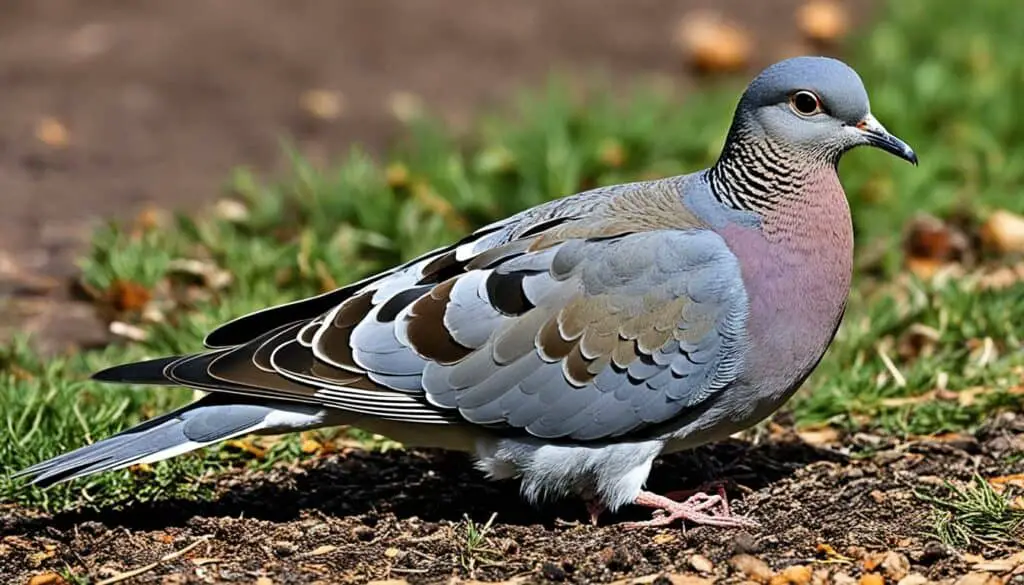
Unique Characteristics
The Mourning Dove stands out with its soft gray feathers. You can see black spots on its wings. It has a small head and a long, pointed tail that is white-tipped. Its call is a soft, sad sound, helping you know it’s near.
Habitat and Diet
Mourning Doves can live in many places like open forests and farms. They also thrive in cities. They look for areas with lots of seeds, which they mostly eat. Doves can spot seeds easily with their sharp eyes and eat a lot of them every day.
When trying to spot a Mourning Dove, look at where they are found and their actions. These clues are key for knowing if it’s one. Watching for them in their common areas is useful when want to identify them.
White-Winged Dove Identification
Identifying a White-Winged Dove means seeing what makes it special and knowing where it likes to live. It stands out from other doves with its unique look and where it can be found. This makes the White-Winged Dove easy to tell apart from other pigeons.
Distinguishing Features
Spotting the White-Winged Dove is easy when it flies because of its wide white wing edges. These, along with its clear white tail tips, are very visible. It also has a mix of light brown and gray feathers, making it subtly unique. Remember these features to correctly identify pigeon species.
Regional Habitats
The White-Winged Dove prefers certain environments. It likes desert shrubs, orchards, and the suburbs. They time their migrations and nesting with the Saguaro cactus’ fruiting, showing a link with this plant. Knowing where they live and their habits can help you spot them in the U.S.
Band-tailed Pigeon Identification
The Band-tailed Pigeon is easy to spot among pigeon species in the U.S. It stands out with its unique looks and actions. This makes it simple to identify.
Physical Traits
The gray band on its tail makes the Band-tailed Pigeon unique. It has a white band on its neck and a shiny patch on its neck. It looks pretty and distinct.
These pigeons have yellow beaks and legs. They are quite large, about 14 to 18 inches long. These features help experts and fans easily spot them.
Behavioral Patterns
Band-tailed Pigeons like the edge of forests more than cities. Unlike Rock Pigeons, they are often found in trees. This shows they prefer woodlands.
They love to eat seeds, especially acorns and berries. What they eat guides where they live. Watching them eat helps in telling them apart from other pigeons.
| Characteristic | Band-tailed Pigeon | Rock Pigeon |
|---|---|---|
| Physical Traits | Gray banded tail, white nape band, iridescent neck patch, bright yellow beaks | Gray plumage, black wing bars, variable patterns |
| Habitats | Forest edges | Urban areas, rocky cliffs |
| Primary Diet | Seeds (acorns, berries) | Varied diet, often anthropogenic |
| Behavior | Arboreal, less urban adaptation | Ground foraging, urban flocking |
Inca Dove Identification
The Inca Dove stands out due to its small size and unique scaly plumage. It is known for “pyramid roosting.” This means they huddle together in a pyramid shape to keep warm during cold weather.
These doves live in places like the desert scrub and near homes. They like to group up when it’s cold and their numbers are growing. These traits make them key in any guide about doves.
Observing what they look like and how they act is the best way to spot an Inca Dove.
Here’s a quick reference for identifying Inca Doves:
| Aspect | Details |
|---|---|
| Size | Small |
| Plumage | Scaly-looking |
| Behavior | “Pyramid roosting” in cold weather |
| Habitat | Desert scrub and suburban areas |
Looking for these special traits and ways they behave can really help with Inca Dove spotting and their protection.
Domestic Pigeons and Their Varieties
Domestic pigeons are a product of careful breeding. They show a wide variety of looks and skills. You can find types used for eating, flying, or just looking pretty.
King Pigeons
King Pigeons are big and white, mainly raised for food. They’re not great at surviving in the wild. Yet, their sturdy bodies and calm disposition have made them popular.
Racing and Homing Pigeons
Racing and Homing Pigeons are known for their speed and smarts. They can fly home from far away. This skill is used in races and to carry messages.
They wear leg bands for identification. This shows where they come from. They are prized for their sharp minds and endurance.
Fancy Pigeons
Fancy Pigeons come in all shapes, colors, and patterns. They are often in shows and loved as pets. The many breeds show how far you can go with breeding.
People love them for their beauty and the stories behind their lineages.
It’s important to know about these pigeons if you like birds in the US.
FAQ
How do you identify different species of pigeons in the USA?
When looking at pigeons in the USA, pay attention to their looks and actions. This includes their coloring, size, and what they do. A good field guide can make spotting different pigeon types easier.
What is the primary difference between pigeons and doves?
While we often use “pigeon” for big birds and “dove” for small ones, it’s not that simple. The size and the actual type of bird can overlap between the two names. So, the difference between pigeons and doves isn’t always clear.
Why is identifying pigeon species important?
Knowing which pigeon is which helps us understand them better. It also plays a key role in protecting them from dangers. By protecting their habitats, we can help these birds thrive.
What are the common characteristics to observe in pigeons for identification?
Look at their colors, especially their backs and necks. Also, notice if they’re bigger and more rounded than doves. How they act, like pecking at food, can also help you tell them apart.
How can you identify a Rock Pigeon?
Rock Pigeons stand out. Look for them in cities and near cliffs. They have grey feathers with black bars on their wings. You can spot them by the way they move and by how they gather in groups.
What are the unique characteristics of Mourning Doves?
Mourning Doves are unlike other birds with their sad sound, slim tails, and fast flights. They’re mostly grey, with black wing spots, and are often seen in open areas. Their diet includes a lot of seeds.
How can you distinguish a White-Winged Dove?
White-Winged Doves are known for the white on their wings when they fly. You’ll see them in dry places, like near deserts and orchards. Besides their unique wings, they also have white on their tails.
What physical traits identify Band-tailed Pigeons?
Band-tailed Pigeons have unique markings like a grey tail with a band, a white ‘scarf’ on their necks, and shiny neck feathers. They are larger and more tree-bound than most pigeons. They especially like the edges of forests.
What are the identifying features of Inca Doves?
Inca Doves are smaller with a distinctive look and are social birds. They often roost in pyramids to keep warm. You’ll find them in desert and suburban areas.
How do you identify different varieties of domestic pigeons?
There are many types of domestic pigeons. King Pigeons are big and white. Racing and Homing Pigeons are built for speed and have special navigation abilities. Fancy Pigeons vary widely in looks because they are bred for specific traits. They are often seen in shows or as pets. Each type has its own unique features and uses.

